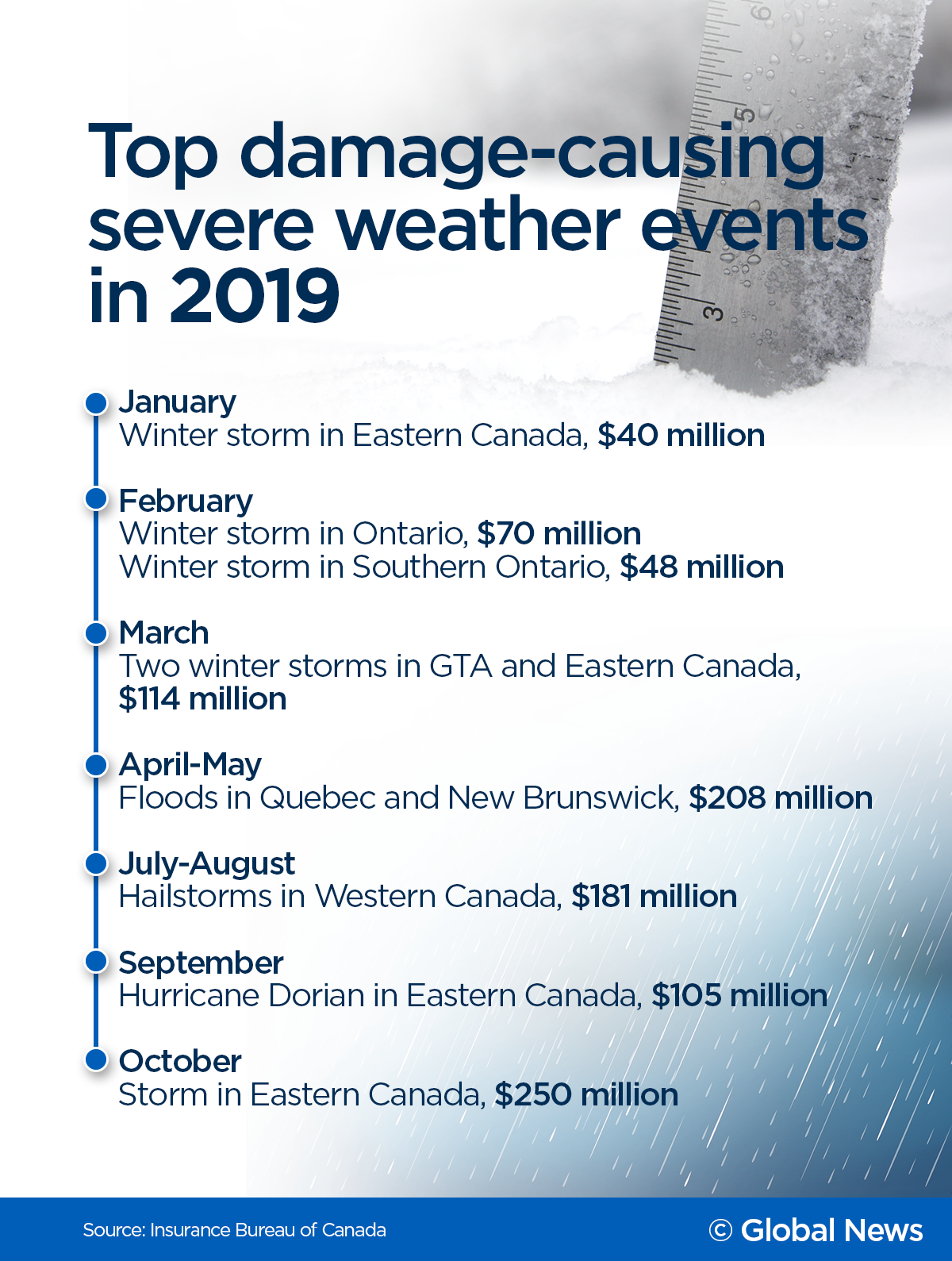Severe weather in Canada — rain, snow, flooding and windstorms — cost $1.3 billion in insured damages last year.

The costs, according to the Insurance Bureau of Canada, made 2019 the seventh most costly year on record.
But unlike other high-ranking years, the report noted insurers experienced damages from a range of severe weather events from coast to coast, rather than one major event.
The highest loss year on record, for example, was 2016, driven by the Fort McMurray wildfires in Alberta. The total cost for that year was $5.261 billion.
The second-highest year, largely due to flooding in the Greater Toronto Area and Alberta, was 2013 and saw costs of $3.4 billion.

Other high-ranking years included severe weather events such as 1998’s Quebec ice storm and 2018’s rain and windstorms in Ontario and Quebec.
In 2019, winter storms in Ontario and Eastern Canada were the most common reasons for insured damages.
The most costly event, however, was an October storm in Eastern Canada that led to damages of $250 million.
IBC, a national association that represents Canada’s private home, auto and business insurers, noted that the widespread events of 2019 indicate that the financial costs of severe weather will only become higher.
“In terms of the number of events and the severity of the events, there’s no doubt that climate change is causing an increase in severe weather across Canada,” Craig Stewart, the vice-president of federal affairs at IBC, told Global News.
“As a result, it’s costing Canadians and insurers and costing taxpayers. But it’s also costing us in losses, direct losses to property across the country, whether it be from windstorms, ice storms, flooding or wildfires.”
The organization said all levels of government in Canada need to take actions to prepare for the risks that climate change brings. That includes upgrading infrastructure so it can handle flooding and fires, among other steps.

Stewart said that would include a four-pronged national action plan on how the country addresses flooding.
The first would be to relocate individuals facing the highest risk of flooding, he said. The second would be to invest in infrastructure to protect structures such as dams and culverts.
He said the third step would involve insuring remaining Canadians through a national high-risk insurance pool, which he noted would require collaboration between insurers and the government.
The fourth step would entail improvements to flood mapping across the country.
Canada is the only G7 country without a national flood forecasting system in place, but Stewart said the process is underway. Global News reached out to Public Safety Canada over email on the progress of that plan, but did not hear back by publication.
The federal government’s bills for dealing with natural disasters neared half a billion dollars in two of the last three years amid warnings to Canadians that this country was one of the worst affected by climate change in 2018.
Data from Public Safety Canada lists the average annual bill for disaster assistance at $430 million over the last three years. That includes $485.8 million in 2016-17, $494.9 million in 2017-18 and $309.5 million in 2018-19. In the five years before that, the federal government’s average annual disaster clean-up bills were $360 million, which was three times the average costs in the five years before that.

Spring flooding and major rainstorms accounted for 80 per cent of the weather events that qualified for disaster funding in the last three years.
A United Nations report from September 2019 outlined that Canada will be hit by water shortages and yearly flooding due to climate change.
By 2060 — within the lifetime of about half of Canadians now living — coastal floods off British Columbia and the Maritimes that used to occur once a century will be annual events, the report said.
Anna Ziolecki, the director of Partners for Action at the University of Waterloo, explained that increased flooding will affect Canadians beyond just B.C. and the Maritimes. She said Canadians living around any waterways, such as the Great Lakes, should also be cautious.
- As Loblaw boycott begins, what to know about all the company’s brands
- Poilievre allowed back in House of Commons after getting kicked out Tuesday
- $34B Trans Mountain pipeline expansion project opens after years of construction
- N.S. man stuck abroad due to lack of available hospital beds ‘in our own province’
“Flooding is something that I think all communities should be aware of and need to be prepared for, whether you’re living in an urban centre or in rural community or in a coastal area,” said Ziolecki, who works with groups and experts to increase Canada’s flood resiliency.
Beyond those individuals, she noted all Canadians end up paying for climate change or flood-related damage.
“Even if you’re not affected personally, you’re paying for it as a Canadian, because our tax dollars are going toward disaster assistance.”
Ziolecki said there are steps Canadians can take to make their homes more resistant to flooding — but many often don’t.

She said past research her organization has done indicates most Canadians don’t invest in property-level measures, such as installing a backwater valve or ensuring their basement is water-resistant.
For those living in high-risk areas, finding a permanent solution other than moving can be difficult.
“It’s a very difficult situation for people living in areas that are at increased risk. Most Canadians don’t know where to go to find that information when buying a home,” she said.
“We need to invest in infrastructure, but we also know that’s not enough,” she said. “In addition to infrastructure, we need good policy and policy that will help us move away from high-risk areas.”
— With files from The Canadian Press




Comments